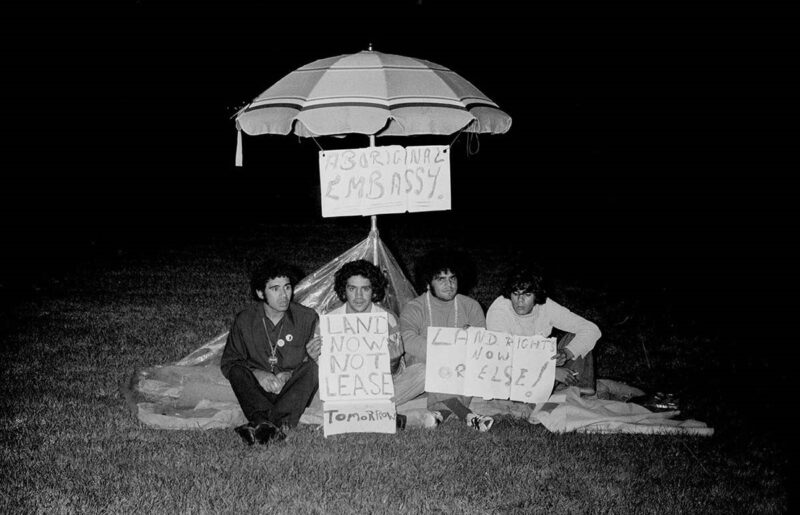The Aboriginal Tent Embassy is a symbolic and political site located in Canberra, opposite Parliament House. On 26 January 1972, four Aboriginal activists: Michael Anderson, Billy Craigie, Bertie Williams, and Tony Correy, erected a symbolic beach umbrella stake with a sign that said, “Aboriginal Embassy.”
The use of the word ‘embassy’ emphasised the fact that Aboriginal people had never ceded sovereignty or had been engaged in treaty processes with the Australian Government.

Photo credit: National Museum of Australia. 1972 Canberra Tent Embassy to Parliament. Pictured are activists, Michael Anderson, Billy Craigie, Bertie Williams, and Tony Correy.
What the Tent Embassy stood for
In the weeks that followed, this protest received a lot of media attention and support from Aboriginal and non-Aboriginal people. On 6 February 1972, the Embassy issued a list of demands to the Government that were focussed on issues relating to land rights, including:
- Full rights to the Northern Territory as a state in Australia, including the installation of a primarily Aboriginal State Parliament. These rights would also include all mining rights to the land
- Ownership and mining rights of all other Aboriginal reserve lands within Australia
- Ownership of areas in major Australian cities. Including mining rights
- Preservation of sacred sites in Australia
- Compensation for lands that weren’t able to be returned to First Australians, starting with $6 billion and including a percentage of the gross national income annually.
Not going anywhere
By July that year, police dismantled the Tent Embassy. Though, it returned in 1973 after activists sat with then-Prime Minister Gough Whitlam. The protest led to the 1976 Aboriginal Land Rights Act, allowing land claims in the Northern Territory.
The embassy continued to move sites until its permanent return in 1992. In 1995, it was listed on the Register of the National Estate. The landmark Eddie Mabo case, in 1992, recognised the native title, leading to the Native Title Act 1993.
40 and 50 years on
Despite attempts to remove it, the embassy persisted. In 2008, Prime Minister Kevin Rudd issued a formal apology. The 40th Anniversary celebration of the Aboriginal Tent Embassy was celebrated in 2012, but not without controversy, with Opposition Leader Tony Abbott’s remarks leading to protests.
Now, more than 50 years on, we continue to reflect on the activism. The embassy emphasises the need to address ongoing injustices for First Nations people. It advocates for action in supporting initiatives for reconciliation, especially following the devastating outcome of the 2023 Voice to Parliament referendum and efforts towards “Closing the Gap.”
A symbol of resilience and activism
The Aboriginal Tent Embassy serves as a profound symbol of the resilience and activism of Aboriginal and Torres Strait Islander peoples. It is essential for us to recognise the injustices they continue to face today. As a nation, we still have a significant journey ahead in the path to reconciliation. Anglicare is dedicated to fostering a culture of deep listening and understanding towards First Australians, and we will persist in standing alongside them, advocating for their ongoing pursuit of justice, recognition, and equality.
